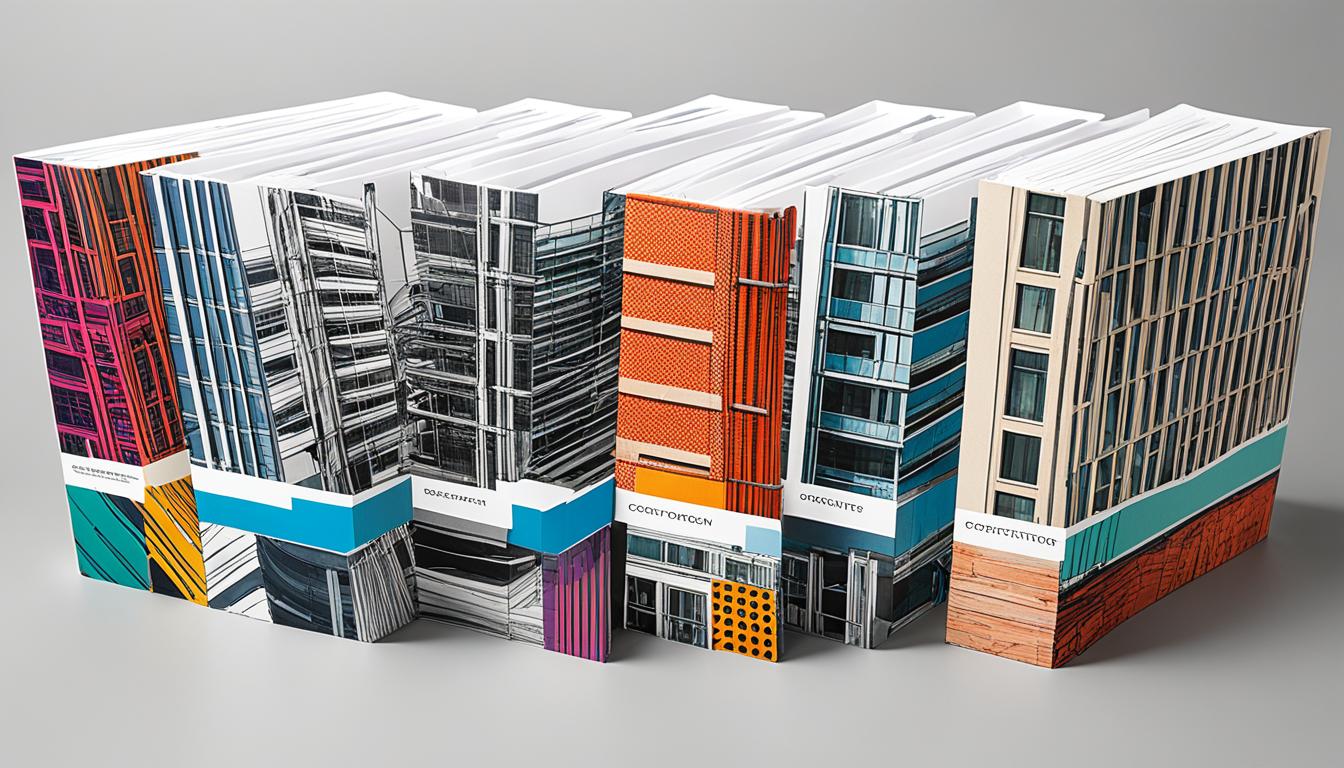How to Create an Impressive Architecture Student Portfolio
As an aspiring architect, crafting an impressive portfolio is a crucial step towards standing out to top schools and firms. Your architecture student portfolio serves as a reflection of your skills, creativity, and design process, highlighting your potential as a future architect.
In this article, I will provide you with valuable tips and guidelines on how to create an impressive architecture student portfolio that will captivate admissions committees and potential employers.
Key Takeaways:
- Select a variety of design projects that showcase your skills and creativity.
- Organize your portfolio in a logical and visually appealing manner.
- Pay attention to the visual presentation of your work, ensuring it is clear and professional.
- Provide insight into your design process to demonstrate your creative thinking.
- Regularly update and refine your portfolio as you progress in your studies and career.
Understanding the Importance of a Well-Designed Portfolio
A well-designed portfolio is essential for architecture students to showcase their work and attract the attention of admissions committees and potential employers. Whether you’re applying to architecture school or seeking career opportunities, a professional portfolio can make a significant impact on your chances of success. It serves as a visual representation of your skills, creativity, and design prowess, allowing you to demonstrate your capabilities in a tangible and impactful way.
When creating your portfolio, it’s crucial to curate a diverse selection of design projects that highlight your unique talents and expertise. The projects you choose should not only display your technical skills but also showcase your ability to think critically and solve complex design problems. Including a range of projects, from conceptual designs to completed construction drawings, can provide a comprehensive view of your capabilities and potential.
Remember, your portfolio is your opportunity to shine and distinguish yourself from other applicants or competitors. It should reflect your personal style and approach to architecture, allowing your individuality and creativity to shine through. Captivating visuals, clear and concise annotations, and thoughtful organization can significantly enhance the impact and effectiveness of your portfolio.
The Power of Visual Presentation
Visual presentation plays a vital role in capturing the attention and interest of those reviewing your portfolio. The way you present your work can communicate your design sensibility, attention to detail, and overall professionalism. Consider the following tips:
- Use high-quality images that clearly showcase your design projects. This enhances the visual appeal and ensures that the details of your work are easily discernible.
- Pay attention to composition and layout to create visually pleasing and cohesive portfolio pages. Utilize design principles like hierarchy and balance to guide the viewer’s eye.
- Include sketches, renderings, and diagrams to demonstrate your design process, problem-solving skills, and ability to communicate ideas visually.
- Arrange your projects in a logical sequence, creating a narrative flow that allows the viewer to understand the evolution of your skills and design thinking.
By investing time and effort into the visual presentation of your portfolio, you can make a lasting impression on admissions committees and potential employers, effectively demonstrating your professionalism and passion for architecture.

Emphasizing Design Projects and Achievements
One of the key aims of your portfolio is to showcase your design projects and highlight your accomplishments. Here are some strategies to effectively emphasize your work:
- Select a variety of projects that demonstrate your range of skills, creativity, and versatility as an architect.
- Include projects that align with the specificities and requirements of the architecture school or firm you are targeting.
- Highlight any awards, recognitions, or notable achievements you have garnered throughout your academic or professional journey.
- Provide concise and compelling descriptions for each project, outlining your design intentions, challenges overcome, and innovative solutions employed.
By focusing on the quality and diversity of your design projects, you can effectively showcase your abilities and secure opportunities for architecture school admission or employment.
A Glimpse Into the Design Process
Showcasing your design process in your portfolio provides valuable insights into your thoughts, methodology, and problem-solving skills as an architect. By incorporating sketches, diagrams, and explanations of your design decisions, you can engage the viewer and demonstrate your ability to think critically and creatively. Furthermore, explaining your design process helps you stand out and adds dimension to your portfolio, making it more compelling and memorable.
Design is about problem-solving and creativity, and by illustrating how you approach design challenges, you provide valuable context and story within your portfolio.
Remember to strike a balance between detailed explanations and concise descriptions, focusing on the most critical aspects of each design project’s development. Clear annotations that effectively communicate your design intent and decisions will leave a lasting impression on those reviewing your portfolio.
| Portfolio Elements | Tips |
|---|---|
| High-quality images | Ensure images are well-lit and clearly capture the details of your work. |
| Cohesive layout | Pay attention to composition, hierarchy, and balance to create visually pleasing pages. |
| Project variety | Select a diverse range of projects that showcase different design skills and interests. |
| Design process | Explain your design thinking and methodology to showcase your problem-solving skills. |
| Clear annotations | Concisely explain your design decisions and intentions to provide context and insight. |
Tips for Crafting an Effective Architecture Student Portfolio
When it comes to creating an architecture student portfolio, there are several key factors that contribute to its effectiveness. Paying attention to portfolio organization, project selection, visual presentation, and showcasing the design process can make a significant impact on how your portfolio is perceived. Here’s how you can optimize each element to create an impressive portfolio:
Portfolio Organization
Organizing your portfolio in a logical and visually appealing way is crucial for creating a positive first impression. Consider categorizing your projects into sections based on their themes, such as residential, commercial, or urban design. You can also organize them chronologically to showcase your growth and progression as a designer.
Project Selection
The projects you choose to include in your portfolio should demonstrate your range of skills and interests. Select a variety of design projects that highlight different aspects of your abilities and showcase your versatility. Aim to include projects that align with the type of architecture you are interested in pursuing in the future.
Visual Presentation
The visual presentation of your portfolio plays a crucial role in capturing the attention of admissions committees and potential employers. Ensure that your visuals are clear, professional, and visually engaging. Use high-quality images, renderings, and diagrams to effectively communicate your design concepts and ideas.
Showcasing the Design Process
Providing insight into your design process can give viewers a deeper understanding of your creative thinking and problem-solving abilities. Include sketches, models, and written explanations that showcase the evolution of your projects. This will demonstrate your ability to think critically and develop innovative design solutions.
“An effective architecture student portfolio demonstrates strong organization, thoughtful project selection, visually appealing presentation, and highlights the design process.” – Jane Smith, Architect
By incorporating these tips into the creation of your architecture student portfolio, you can increase your chances of making a lasting impression on admissions committees and potential employers. A well-crafted and thoughtfully presented portfolio will demonstrate your skills, creativity, and passion for architecture. Remember to continuously update and refine your portfolio as you progress in your studies and career.
| Element | Tips |
|---|---|
| Portfolio Organization | Categorize projects based on themes or chronology |
| Project Selection | Include a variety of projects that showcase your skills and interests |
| Visual Presentation | Use high-quality images and visuals to capture attention |
| Showcasing the Design Process | Include sketches, models, and explanations of your design process |
Presenting Your Architecture Student Portfolio: Dos and Don’ts
When presenting your architecture student portfolio, it is crucial to keep in mind the dos and don’ts that can make or break your presentation. By following these guidelines, you can showcase your portfolio in the most effective way and leave a lasting impression on admissions committees and potential employers.
Do Prepare for Interviews and Presentations
Interview preparation is key to successful portfolio presentation. Practice your presentation skills, pay attention to your body language, and articulate your design thinking effectively. By being well-prepared, you can confidently discuss your projects, highlight your creative process, and express your passion for architecture.
Don’t Include Irrelevant or Low-Quality Work
When curating your architecture student portfolio, ensure that it only includes your best work. Avoid including projects that are not relevant to the field or do not showcase your skills and creativity. Quality should always take precedence over quantity. Including low-quality work can negatively impact the overall impression of your portfolio.
Do Regularly Update Your Portfolio
Your portfolio should be a dynamic reflection of your growth and progress as an architecture student. Continuously update it with your latest and most impressive projects. Regular updates demonstrate your dedication to your craft and your commitment to staying relevant in a swiftly evolving industry.
Don’t Neglect to Seek Feedback
Feedback from professionals in the field can provide invaluable insights and help you refine your portfolio. Reach out to architects, professors, and industry experts for constructive criticism. Their feedback can help you identify areas of improvement and further strengthen your portfolio.
Do Present Your Portfolio with Confidence and Professionalism
When presenting your architecture student portfolio, exude confidence and professionalism. Practice your presentation skills, maintain eye contact, and speak clearly. Showcase your unique strengths and convey your passion for architecture through your portfolio. Remember, it is not just about the projects but also about your ability to communicate your ideas effectively.

Remember, your portfolio is a representation of your skills, creativity, and potential as an architect. By following these dos and don’ts, you can ensure that your portfolio stands out, leaving a lasting impression on those who review it. Take the time to prepare, curate, and present your portfolio in the most professional manner possible.
Conclusion
Crafting an impressive architecture student portfolio is a crucial step towards a successful career in the field. By following the tips and guidelines outlined in this article, you can create a portfolio that effectively showcases your skills, creativity, and design process, increasing your chances of getting admitted to architecture school or landing a job in the industry.
Remember to continuously update and refine your portfolio as you progress in your studies and career. As an architecture student, your portfolio is a living document that should evolve alongside your growth and accomplishments. Regularly evaluate your work, replacing older projects with new ones that reflect your current abilities and interests.
It’s also important to seek feedback from professionals in the field to ensure that your portfolio resonates with industry expectations. Pay attention to the presentation of your portfolio, ensuring that it is visually appealing and showcases your work in the best possible light.
By leveraging these portfolio tips, you can position yourself as a standout candidate, ready to embark on a successful architecture career.








